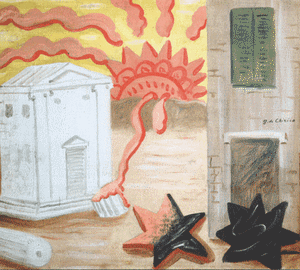
Description of the picture:
The rising sun is Giorgio de Chirico. 1930. Wood, tempera
Giorgio de Chirico (1888-1978), an Italian painter and art theorist, rightfully considered one of the harbingers of surrealism in modern painting, in the second half of his life moved away from innovative thoughts, seeking inspiration in the forms of traditional art. After the success at the Paris exhibition in 1925, he increasingly began to borrow plots for his own paintings from Greco-Roman mythology. The old Mediterranean civilization was native to the master, who was born and spent his childhood and adolescence in Greece, and his youth and mature years in Italy.
Rising Sun – symbolic image of the ancient world, the time of the emergence of European culture. In a picture with such a title, de Chirico indicates how the sun puddles the golden sky with human-like rays and sandy sand, touching fragments of ancient architecture, lying at the foot of a small temple, styled in antique spirit, crowned with a triangular pediment, which rests on a half-column of ionic warrants. Huge starfish cast ashore are visible in the vicinity. The sea is not visible, but in front of the viewer are its inhabitants. Ancient civilization was coastal, all its large centers were not removed from the coast further than 60 km. Opposite the ancient temple is a conditionally depicted, but recognizable typical Italian house with shutters, possibly symbolizing the continuity of cultures. Although the painter was inspired by interest in the classical heritage, his artistic language and imaginative system were still closely connected with the previous period of creativity. The whole picture is a set of signs seen as if in a dream or vision. It is obvious, however, that it does not arise spontaneously in the imagination of the artist, but is the result of thought and reflection, clothed in the form of random fantasy."